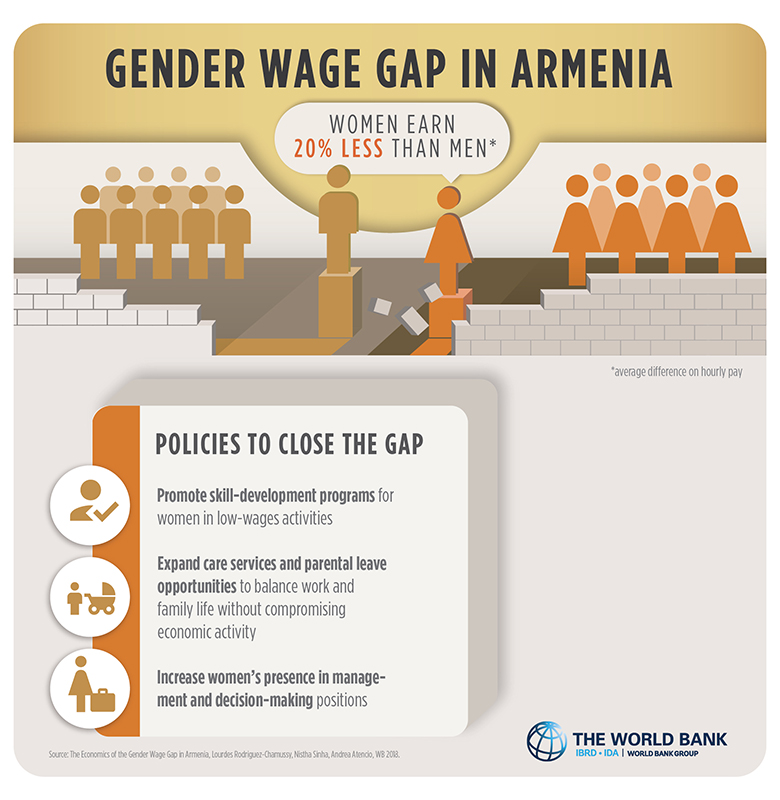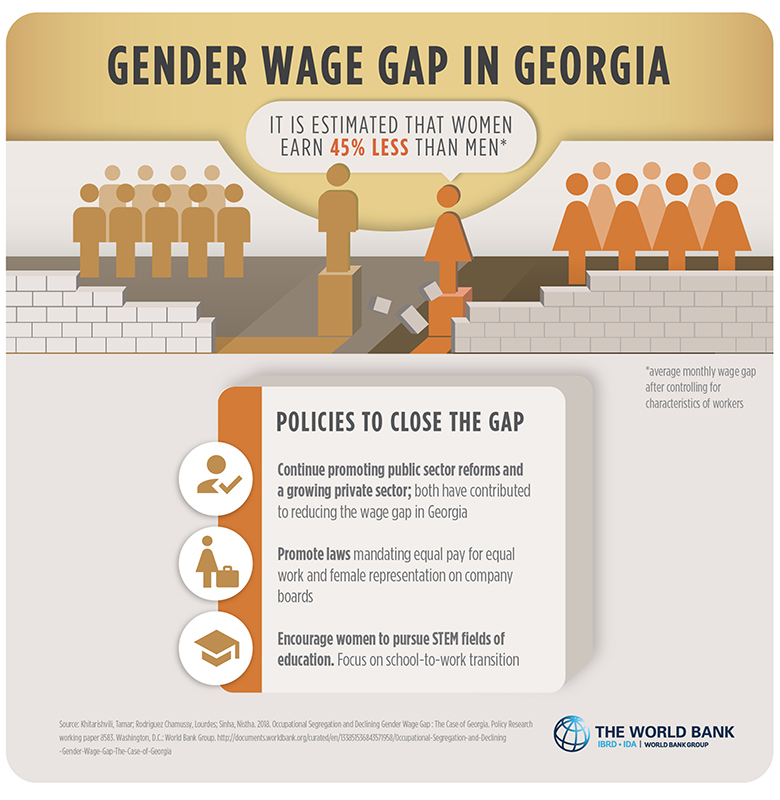
In the countries of the South Caucasus – Armenia, Azerbaijan and Georgia – women generally receive the same level of tertiary education as men, and they comprise almost half the workforce. But, if a woman and a man hold the same work position, in the same location, at the same point in their careers, the woman usually earns about 36% less per year than the man. If that sounds unfair to the woman, that’s because it is.
So why do gender pay gaps persist, and why should we care?
First of all, we must recognize that gender inequality is a global problem. Gender pay gaps exist in all countries – from high-income to low-income – and represent one of the most persistent barriers to achieving gender equality in society. Indeed, Target 8.5 of the 2030 Sustainable Development Goals calls for “equal pay for work of equal value.”
There is some good news for the South Caucasus: overall, the gender pay gap here is shrinking, albeit slowly. Recently enacted gender equality policies and laws, combined with a steady reduction over the years in the education gap between young women and men, are having a positive impact.
At the same time, both Georgia and Armenia still have significant differences between employment earnings among women and men, compared to the average across countries in Europe. What explains the persistent gender wage gap in these two countries?
In Georgia, according to our research, as much as 23% of female workers are employed in only two sectors – health and education – compared with just 5% of male workers. Meanwhile, half of female workers are employed in white-collar occupations, compared with 9% for male workers.
Female workers in Armenia tend to dominate professions such as agricultural work, sales, and customer service, which usually pay the lowest salaries. Even in better-paid professions, most employed women do not work full-time because of the demand on their time for home-care and other unpaid household responsibilities. And, even if an Armenian woman is more highly educated than a man, she will likely earn less than he does.
Gender gaps begin early, in the primary school years, and widen at higher levels of the education system.
In Georgia, the percentage of tertiary-level female graduates in fields such as arts and humanities, education, and health, is twice that of men. On the other hand, the percentage of female graduates from Science, Technology, Engineering and Mathematics (STEM) fields is less than half that of male graduates.
In Armenia, the situation is a bit puzzling: when it comes to tertiary education, enrollment and completion rates are higher for women than for men. Yet, women tend to opt out of STEM fields, even though these fields are increasingly in high demand and pay more.
One cannot overstate the importance of policy interventions and strategic actions by governments and other stakeholders to close the gender gaps in the South Caucasus.
When it comes to remuneration, we need laws that mandate equal pay for equal work, legal frameworks that ensure stronger representation of women on company boards, and policies that support increased involvement of women in management and decision-making positions.
Family-friendly labor market policies aimed at balancing women’s time between family and work – such as the provision of early childhood education and child care services – can offset unpaid care provided by mothers and increase women’s participation in the labor force.
Greater support and encouragement of young women to pursue STEM studies would have a positive self-reinforcing effect that can lead to increased participation in high-paying professions and fields. Along with policy interventions that facilitate the transition from school to work, such encouragement would boost women’s investment in tertiary education and ultimately employment, helping close the gender pay gap.
At the World Bank, we provide both advisory and financial support to help countries address gender gap issues. In Armenia, for example, we are working with local authorities in rural areas to provide kindergarten and pre-school services for young children, so that mothers can participate actively in the labor force.
In Georgia, we are working with the government to improve access to high-quality early childhood education and child-care in rural areas, and to increase the participation of girls in STEM education across the country.
We are also supporting business collectives for women in rural areas of Azerbaijan, so that they can have better premises and resources to prepare business projects, while their children are looked after in nearby child-care facilities.
In the South Caucasus, we care about closing the gender gaps. Because women should be empowered to participate equally in the economy. Because a woman should earn the same pay as a man for doing the same work. Because every woman and girl should have an opportunity to achieve their dreams.



